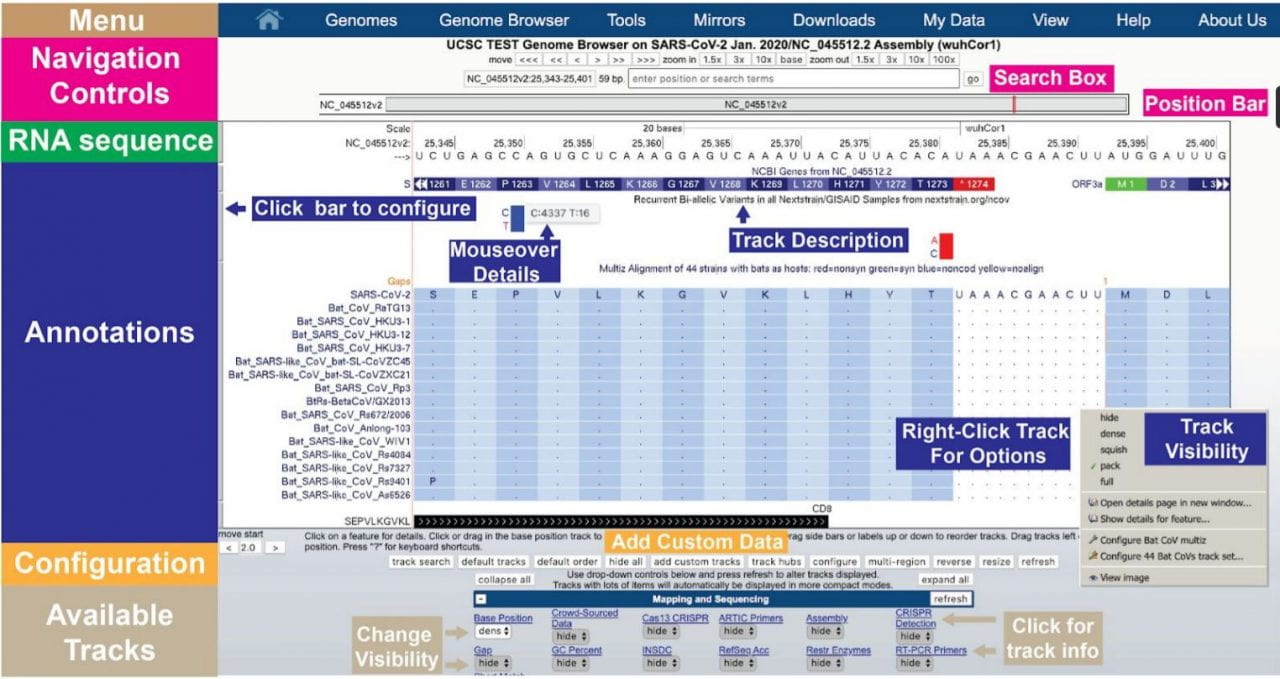
The UCSC Genome Browser features a Coronavirus Browser to help researchers visualize the coronavirus genome that causes COVID-19. Refer to the tutorial and video here: http://bit.ly/3qzPyQd. UCSC’s coronavirus browser maps gene and protein alignments, global variants, and even the genomes of variants from other species like bats and pangolins. It draws on sequencing data from around the world, and is intended to support virology and epidemiology research to end the pandemic.
Abstract
Background Researchers are generating molecular data pertaining to the SARS-CoV-2 RNA genome and its proteins at an unprecedented rate during the COVID-19 pandemic. As a result, there is a critical need for rapid and continuously updated access to the latest molecular data in a format in which all data can be quickly cross-referenced and compared. We adapted our genome browser visualization tool to the viral genome for this purpose. Molecular data, curated from published studies or from database submissions, are mapped to the viral genome and grouped together into “annotation tracks” where they can be visualized along the linear map of the viral genome sequence and programmatically downloaded in standard format for analysis.
Results The UCSC Genome Browser for SARS-CoV-2 (https://genome.ucsc.edu/covid19.html) provides continuously updated access to the mutations in the many thousands of SARS-CoV-2 genomes deposited in GISAID and the international nucleotide sequencing databases, displayed alongside phylogenetic trees. These data are augmented with alignments of bat, pangolin, and other animal and human coronavirus genomes, including per-base evolutionary rate analysis. All available annotations are cross-referenced on the virus genome, including those from major databases (PDB, RFAM, IEDB, UniProt) as well as up-to-date individual results from preprints. Annotated data include predicted and validated immune epitopes, promising antibodies, RT-PCR and sequencing primers, CRISPR guides (from research, diagnostics, vaccines, and therapies), and points of interaction between human and viral genes. As a community resource, any user can add manual annotations which are quality checked and shared publicly on the browser the next day.
Conclusions We invite all investigators to contribute additional data and annotations to this resource to accelerate research and development activities globally. Contact us at genome-www{at}soe.ucsc.edu with data suggestions or requests for support for adding data. Rapid sharing of data will accelerate SARS-CoV-2 research, especially when researchers take time to integrate their data with those from other labs on a widely-used community browser platform with standardized machine-readable data formats, such as the SARS-CoV-2 Genome Browser.
#SARSCoV2 #sequencing #coronavirus #variant #virology #epidemiology #research